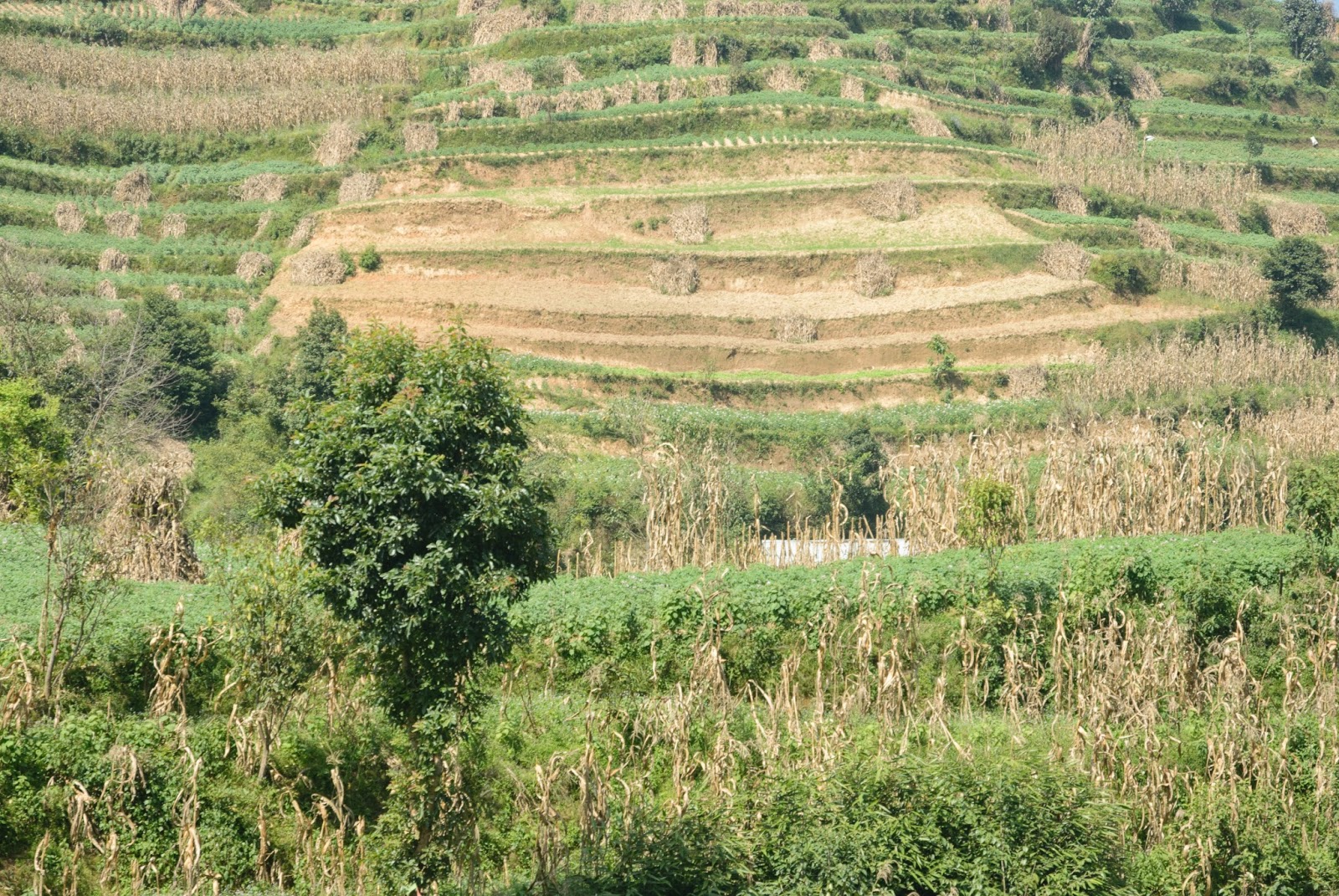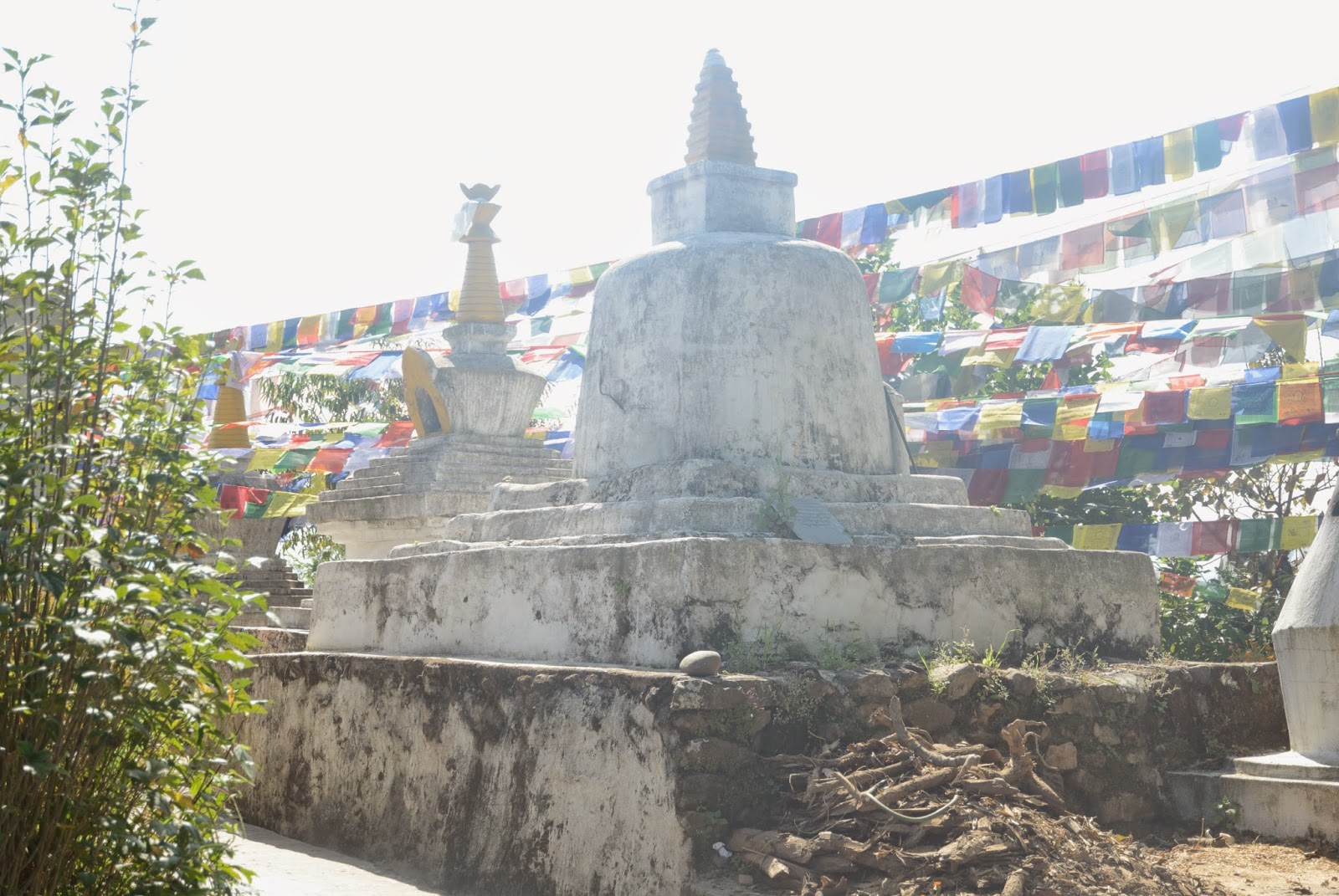The main attraction for most visitors to Dhulikhel is the day trip to Namobuddha. Nested on top of a tall hill it is another of the most important Buddhist stupas in Nepal and remains a sight of pilgrimage for many devotees. Leaving from Dhulikhel it is possible to go directly to Namobuddha and back which takes around 3.5 hours each way of constant walking, or it is also an option to continue on to Panauti (another 3 hours) and take a bus back to Dhulikhel via Banepa. We chose to do the latter and it took us considerable longer then the 6 hours anticipated, and after a bit over 8 hours walking we chose to hitchhike the remaining few kilometers to arrive before dark.
La atraccion principal de la mayoria de los visitantes de Dhulikhel es el viaje hacia Namobuddha que se hace de dia. Anidado en la punta de una alta colina, es otra de las importantes stupas Budistas en Nepal y es considerada un importante sitio de pelegrinaje para muchos devotos. Saliendo de Dhulikhel es posible ir directamente a Namobuddha y regresar en unas 3,5 horas de marcha constante de ida y vuelta, o tambien es una opcion de continuar hacia Panauti (que toma otras 3 horas) y de ahi tomar un bus hacia Dhulikhel via Banepa. Escogimos este ultimo camino que nos tomo considerablemente mas de las 6 horas que se anticipan, y despues de un poco mas de 8 horas de caminata decidimos hacer stop para los ultimos kilometros faltantes.
Golden Buddha on the way to Kali Temple / Buddha Dorado en la via al Templo de Kali
The first half of the walk is constantly up and down, the mountains like waves as far as the eye can see. Upon Leaving the town of Dhulikhel and climbing the 1000 steps heading first to the giant golden Buddha and next to the top of the mountain ridge where the Kali Temple lies; you follow by intuition the small path leading to the other side of the mountain and to the right. From then on the path varies between small walking trails and dirt roads passing through a few small villages and one large stupa that serves both as a resting place for hikers and a point of reference . The path always seems to be clinging onto one or another side of the mountain ridge almost always with a beautiful panorama of the Himalayas.
La primera mitad de la caminata es un constante bajar y subir, las montañas parecen olas hasta donde alcanza a ver el ojo. Dejando el pueblo de Dhulikhel y subiendo las mil escaleras que llevan primero al gigante Buddha de oro y luego a la cima de la montaña donde se encuentra el templo de la diosa Kali, se sigue casi por intuicion el pequeño camino que lleva al otro lado de la montaña y luego a la derecha. De ahi en adelante, el camino varia entre pequeñas rutas de caminata y rutas despavimentadas que atraviesan unos cuantos pequeños pueblos y una gran estupa que sirve a la vez de lugar de descanso para caminantes y como punto de referencia. El camino parece siempre vertirse de un lado u otro del borde de la montaña casi siempre con un hermoso panorama de los Himalayas.
It is beautiful walking through the small villages on the way to Namobuddha with kids playing cricket and lots of people interesting in a chat. The villages are quite a distance from the main highways and therefor receive minimal contact from visitors. The life in the country seems like incredible hard work, the brunt of the burden falling upon the women, who occupy a very subservant role in the Nepali society. Some (few) informations about this problematic:
Es hermoso pasearse entre los pequeños pueblos en la via hacia Namobuddha con niños jugando cricket y varias personas interesadas en entablar una conversacion. Los pueblos estan a una distancia considerable de las autopistas o grandes senderos asi que parecieran recibir poco contacto de visitantes. La vida en el campo parece un increible y dificil trabajo, un peso que cae sobre los hombros de las mujeres quienes ocupan un lugar aun muy oprimido en la sociedad Nepali. Algunas (pocas) informaciones al respecto:
"Tracking Gender-Based Violence in Nepal", a UN report from 2013 on individual, institutional, legal and policy analysis / "Tracking Gender-Based Violence in Nepal", un reporte en inglés de las Naciones Unidas en 2013 sobre analisis individuales, institucionales, legales y politicas:
Her Turn Association that promotes girls empowerment, education and equality in Nepal. Check their work here: / La Asociacion Her Turn promueve la educacion, equidad y empoderamiento de niñas en Nepal. Aqui su trabajo:
And a UN report of 1999 (quite old but yet tells cleary some facts about women in Nepal) / Un reporte de las Naciones Unidas que data de 1999 (un poco viejo ya pero habla de hechos factuales sobre las mujeres en Nepal):
Namobuddha is situated high on the mountain and can be seen on the last trail of the way. You can tell that it is fact Namobuddha by the thousands upon thousands of tibetan prayer flags and the shining gold paint of its new monastery. It is to say that the contrast between ancient and new is also a striking shade that leads one to ask about the different political and economical matters behind this important site.
Namobuddha esta situado en la cima de una montaña y puede ser visto desde la ultima parte del camino. Se puede decir que es Namobuddha por los miles y miles de banderolas de oraciones tibetanas desplegadas y el brillo de la pintura dorada del nuevo monasterio que se refleja con el sol. Debemos decir tambien que este fuerte contrate entre antiguas y nuevas construcciones en el lugar nos lleva a preguntrnos sobre los diferentes asuntos politicos y economicos que se esconden detras de este importante sitio.




The shrine is important due to its connexion with the very story of Siddartha -Lord Buddha-. The buddha was meditating in the top of the hill where now stands Namobuddha, while a tigress was hunting a goat nearby, the goat approached the meditating buddha and explained its troubles: Buddha, "the tigress is trying to hunt and eat me!" At which point he approached the tigress: "tiger, why are you hunting the goat?" For which the tigress answered: "I haven't eaten for days and I haven't fed my cubs, and we will starve if we do not eat soon". The buddah siddartha then, compelled by his deep compassion, offered his flesh to the tigress so her and her cubs could live long. This is said to have sent Siddartha to a highest stage of consciousness.
Este altar es importante debido a su conexion con la historia de Siddartha – Buddha-. Buddha estaba meditando en la punta de la colina donde ahora se erige Namobuddha, mientras una tigresa estaba cazando una cabra en los alrededores. La cabra se acerco a Siddartha y le hizo parte de su inquietud: "Buda, la tigresa esta intentando cazarme y comerme!" En ese momento, Siddartha se acerco a la tigresa para preguntarle la razon : "Por que estas cazando esta cabra?" La tigresa respondio: "No he comido en dias y no he podido alimentar a mis crios, moriremos de hambre si no comemos pronto". Siddartha el Buddha entonces, llamado por su profunda compasion, ofrendo su carne a la tigresa y sus crias para que pudiesen vivir. Se dice que este acto envio a Siddartha a un estado de consciencia superior.

After leaving Namobuddha the trail descends very rapidly towards the floor of the valley and continues on flat ground with mountains on both sides all the way to Panauti. This second leg of the walk basically entails heading west towards the setting sun hopping from one village to the next along a narrow dirt road. Upon arriving at each village, the next one along the path comes into view. This is not just helpful for orientation, but it is a great feeling to always be seeing the destination, and to arrive at each town that just an hour before was a small, brown, insignificant cluster of buildings on the horizon.
Después de dejar Namobuddha, el camino desciende rapidamente hacia la cuenca del valle y continua durante todo el camino a Panauti en terreno plano y rodeado de las montañas de cada lado. Esta segunda parte de la caminata conlleva al oeste donde se acuesta el sol, saltando de un pueblo a otro a lo largo de el estrecho camino despavimentado. Arribando a cada pueblo, se ve el siguiente al fondo del camino. Esto no es solo util para la orientacion, sino que también otorga una agradable sensacion de siempre poder ver el lugar de destino que una hora antes no era mas que una pequeña, oscura, insignificante mancha de edificios en el horizonte.
































0 comentarios:
Publicar un comentario